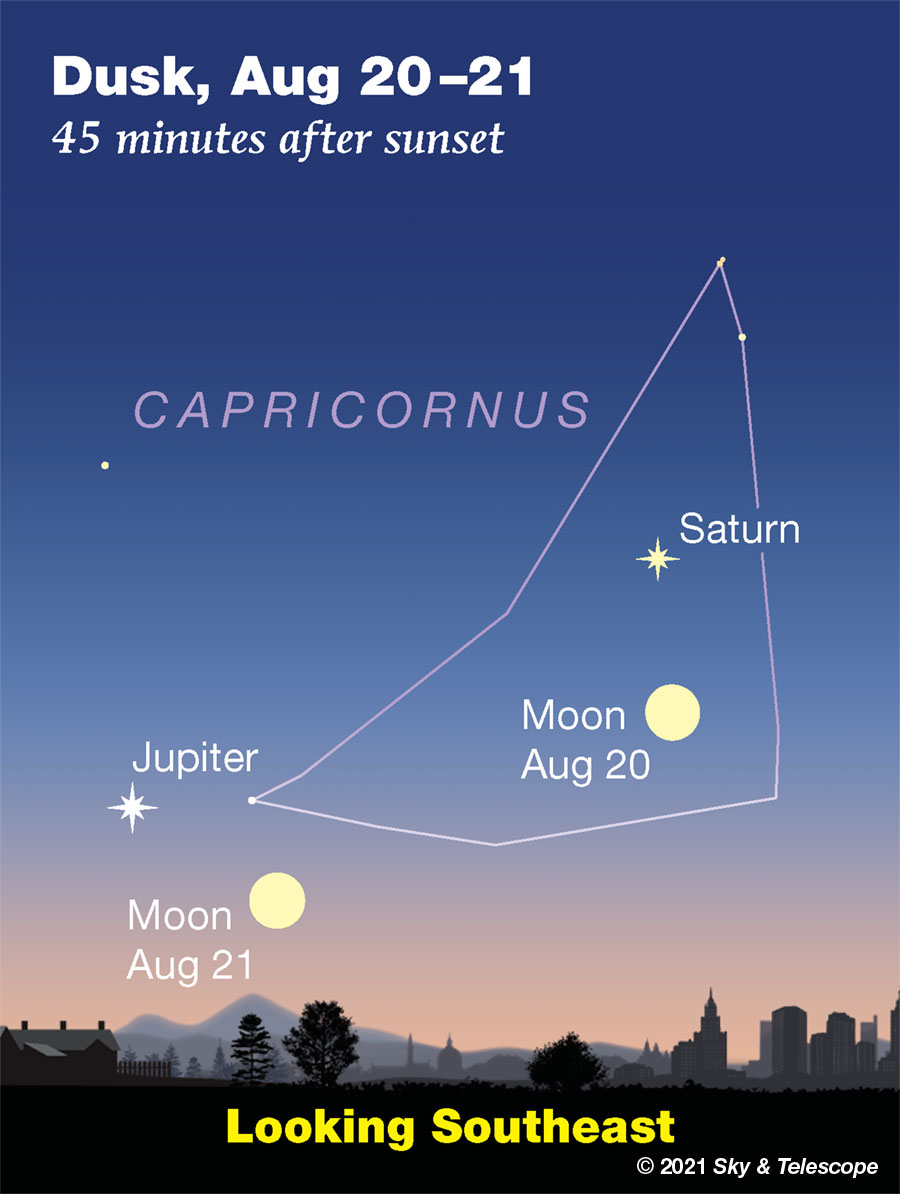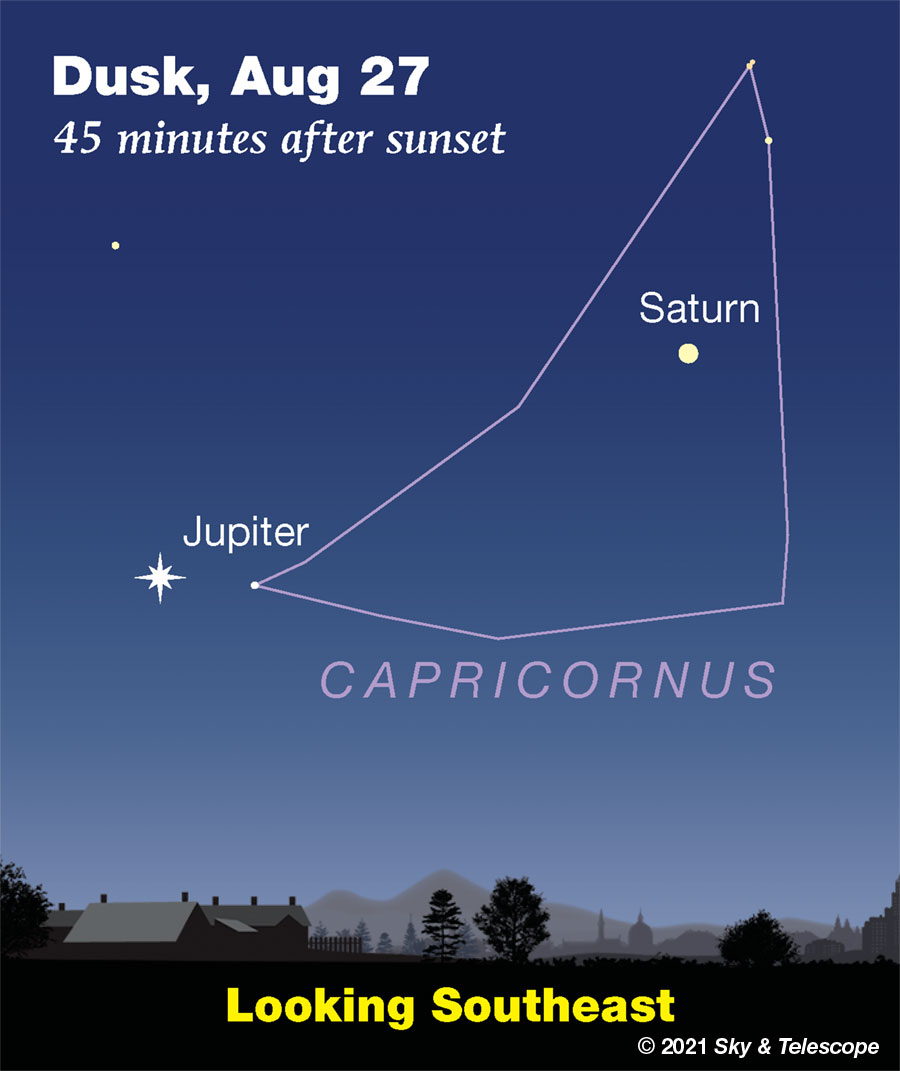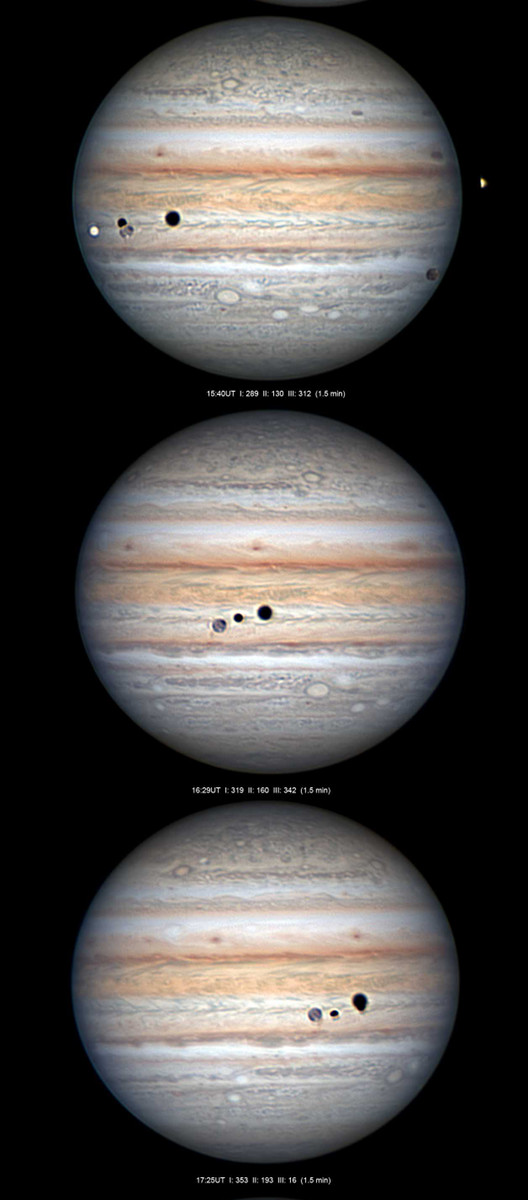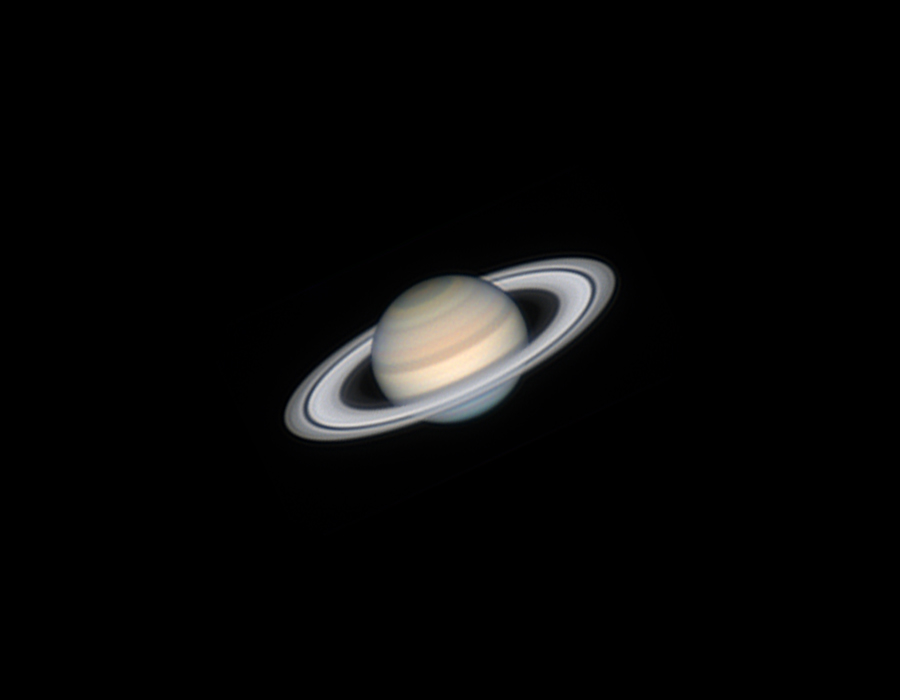RS Ophiuchi fades more slowly. On August 8th the recurrent nova RS Ophiuchi lept from its normal magnitude 11.2 to 4.8, dim naked-eye magnitude, after 15 years of simmering quietly near minimum. It fading rapidly at first, then more slowly. As of August 26th it had held at magnitude 8.0 for four days. See Bob King's Recurrent Nova RS Ophiuchi Just Blew its Top! with finder charts and comparison stars. Ophiuchus is ideally placed high in the early evening sky.
Nova Cassiopeiae 2021, meanwhile, has bounced around in brightness ever since it erupted from 15th magnitude to 7.7 in March. Its biggest bumps were to magnitude 5.5 in early May and 6.0 around July 27th. As of August 26th it too had been holding at 8.0 for several days, after dipping to 8.6 earlier in the month. Cas is also excellently placed in the evening sky. Charts and comparison stars.
FRIDAY, AUGUST 20
■ The Moon shines under Saturn this evening, and Jupiter shines to their left, as shown below.

■ The two brightest stars of summer are Vega, now overhead shortly after nightfall, and Arcturus, shining in the west. Draw a line down from Vega to Arcturus. A third of the way down, the line crosses the dim Keystone of Hercules. Two thirds of the way down it crosses the dim semicircle of Corona Borealis with its one modestly bright star, Alphecca or Gemma.
Also: Vega and the Keystone star closest to it form an equilateral triangle with Eltanin to their north, the nose of Draco the Dragon. Eltanin is the brightest star of Draco's quadrilateral head; he's eyeing Vega.
SATURDAY, AUGUST 21
■ Now the Moon shines under Jupiter, with Saturn to their right. The Moon is full tonight and tomorrow night; exact full phase occurs at 9:02 a.m. tomorrow morning, splitting the date difference (for evening skywatchers in the Americas).
■ As summer progresses and Arcturus moves down the western sky, the kite figure of Bootes sprouting up from Arcturus tilts to the right (depending on your latitude). The kite is narrow, slightly bent with its top leaning right, and 23° long: about two fists at arm's length. Arcturus is its bottom point where the stubby tail is tied on.
The Big Dipper now slants at about the same height in the northwest, to the Kite's right.
SUNDAY, AUGUST 22
■ The Moon again forms a big curving arc with Jupiter and Saturn, but now they're to the Moon's right. The arc spans three fists at arm's length.
MONDAY, AUGUST 23
■ By 10 or 11 p.m. the waning Moon is well up in the east-southeast. Spot bright Jupiter off to its upper right. They form a nearly equilateral triangle with Fomalhaut, the Autumn Star, rising below Jupiter. How early and low can you first see it? Is this your first sighting of Fomalhaut for this year's apparition?
TUESDAY, AUGUST 24
■ Another sign of the advancing season: Cassiopeia is high in the northeast, its W pattern tilting up. And below it, starry Perseus is reaching up.
The highest part of Perseus includes the wintry Double Cluster. To find it, look below the lowest two stars of the Cassiopeia W (they're the faintest two), by somewhat more that the distance between them. You're looking for what seems like a small spot of enhanced Milky Way glow. Binoculars or a finderscope will help you detect the Double Cluster even through a fair amount of light pollution. The pair are a glory in a telescope.
WEDNESDAY, AUGUST 25
■ As August proceeds and nights begin to turn chilly, the Great Square of Pegasus looms up in the east, balancing on one corner. Its stars are only 2nd and 3rd magnitude, and your fist at arm's length fits inside it.
From the Square's left corner extends the main line of the constellation Andromeda: three stars (including the corner) about as bright as those forming the Square.
This whole giant pattern was named "the Andromegasus Dipper" by the late Sky & Telescope columnist George Lovi. It's shaped sort of like a giant Little Dipper with an extra-big bowl, and it's currently lifting its contents upward.
THURSDAY, AUGUST 26
■ Low in the northwest or north at the end of summer twilights, would you recognize noctilucent clouds if you saw them? They're the most astronomical of all cloud types, with their extreme altitude and formation on meteoric dust particles. And they're fairly rare — though becoming more common in recent years as the atmosphere changes. See Bob King's article.
FRIDAY, AUGUST 27
■ Whenever bright Vega crosses nearest your zenith, as it does right after dark now, you know that the Sagittarius Teapot is at its highest due south.
Two hours later when Deneb crosses closest to the zenith, it's the turn of little Delphinus and boat-shaped Capricornus down below it to stand at their highest due south.

SATURDAY, AUGUST 28
■ Now that the Moon is out of the evening sky, it's prime Milky Way time. After dark, the Milky Way runs from Sagittarius in the south, up and a bit left left across Aquila and through the big Summer Triangle high overhead, and on down through Cassiopeia to Perseus low in the north-northeast.
This Week's Planet Roundup
Mercury is very deep in the sunset and fading further, from magnitude –0.4 to –0.1 this week. You might have a chance at it with binoculars or a wide-field scope. About 15 or 20 minutes after sunset, scan for it just above your west horizon about 18° (nearly two fists at arm's length) lower right of Venus. Good luck.
Venus, brilliant at magnitude –3.9, shines pure white in the west-southwest during twilight. It still sets around twilight's end.
Jupiter and Saturn shine in the southeast in late twilight and after dark. They're magnitudes –2.9 and +0.2, respectively, in Capricornus.
Jupiter starts the night lowest. Saturn glows 18° (about two fists) to Jupiter's upper right. The pair levels out around 11 p.m. daylight-saving time. By then they're about at their highest in the south, at their telescopic best.
Saturn reached opposition on August 1st, and Jupiter did so on August 19th. So this month they're at their closest, biggest, and brightest of the year. See "Saturnian Challenges" starting on page 52 of the July Sky & Telescope, also "Action at Jupiter" in the August issue, page 50, and "Dog Days with the Gas Giants" on page 40 of August.

But the best way to follow the sequence events is on video! (Or at least jumpy gif.) The Washington Post has put it all together along with a step-by-step guide to everything that's happening. Here's the story: Watch this ‘surreal’ Jupiter eclipse that you probably missed.

Uranus (magnitude 5.7, in Aries) and Neptune (magnitude 7.8, at the Aquarius-Pisces border) are high in the southeast to south in the early-morning hours.
All descriptions that relate to your horizon — including the words up, down, right, and left — are written for the world's mid-northern latitudes. Descriptions that also depend on longitude (mainly Moon positions) are for North America.
Eastern Daylight Time, EDT, is Universal Time minus 4 hours. Universal Time is also known as UT, UTC, GMT, or Z time. To become more expert about time systems than 99% of the people you'll ever meet, see our compact article Time and the Amateur Astronomer.
Want to become a better astronomer? Learn your way around the constellations. They're the key to locating everything fainter and deeper to hunt with binoculars or a telescope.
This is an outdoor nature hobby. For an easy-to-use constellation guide covering the whole evening sky, use the big monthly map in the center of each issue of Sky & Telescope, the essential magazine of astronomy.
Once you get a telescope, to put it to good use you'll need a detailed, large-scale sky atlas (set of charts). The basic standard is the Pocket Sky Atlas (in either the original or Jumbo Edition), which shows stars to magnitude 7.6.

Next up is the larger and deeper Sky Atlas 2000.0, plotting stars to magnitude 8.5; nearly three times as many. The next up, once you know your way around, are the even larger Interstellarum atlas (stars to magnitude 9.5) or Uranometria 2000.0 (stars to magnitude 9.75). And be sure to read how to use sky charts with a telescope.
You'll also want a good deep-sky guidebook, such as Sky Atlas 2000.0 Companion by Strong and Sinnott, or the bigger (and illustrated) Night Sky Observer's Guide by Kepple and Sanner.
Can a computerized telescope replace charts? Not for beginners, I don't think, and not on mounts and tripods that are less than top-quality mechanically, meaning heavy and expensive. And as Terence Dickinson and Alan Dyer say in their Backyard Astronomer's Guide, "A full appreciation of the universe cannot come without developing the skills to find things in the sky and understanding how the sky works. This knowledge comes only by spending time under the stars with star maps in hand."
![]() Audio sky tour. Out under the evening sky with your
Audio sky tour. Out under the evening sky with your
earbuds in place, listen to Kelly Beatty's monthly
podcast tour of the heavens above. It's free.
"The dangers of not thinking clearly are much greater now than ever before. It's not that there's something new in our way of thinking, it's that credulous and confused thinking can be much more lethal in ways it was never before."
— Carl Sagan, 1996
"Facts are stubborn things."
— John Adams, 1770
 7
7









Comments
tom-dasilva
August 20, 2021 at 12:11 pm
can't see any nighttime sights here. Central CA is smoke central.
You must be logged in to post a comment.
Rod
August 21, 2021 at 8:17 am
tom-dasilva, Rod in Maryland here. I have seen reports on the smoke in your area, sometimes it moves across the sky high up near me too. Weather at my location is poor. T-storms, rain showers, and cloudy nights. My last observation was a few August Perseids early near 0500 EDT on August 12th. I may have better viewing this coming Tuesday evening. I cleaned my 10-inch Newtonian and collimated it, need to star test in the field 🙂 I use a 90-mm refractor telescope too on an alt-azi tripod and mount.
You must be logged in to post a comment.
misha17
August 23, 2021 at 9:39 pm
On Sept 2nd, the Sun will be at decl. +7 degrees North - the same declination it will be for the Apr 8, 2024 total solar eclipse . Sunrise times are about the same for both days, so conditions (altitude, sky position) will be similar time-wise for both days.
Folks planning to view the eclipse near their homes can use the Eclipse Simulator
( https://eclipse2024.org/eclipse-simulator/ )
mentioned in the Apr 8, 2021 Sky And Telescope article
( https://skyandtelescope.org/astronomy-news/t-3-years-til-the-2024-total-solar-eclipse/ )
to get eclipse times, then go outside on Sep 2nd and see where the sun will appear for Apr 8, 2024.
Since Sept 2nd falls so close to the Labor Day weekend, if folks were going to travel to nearby landmarks (parks, mtns, etc) for the eclipse, they can travel on the holiday weekend to scope out (no pun intended) good viewing sites.
You must be logged in to post a comment.
misha17
August 24, 2021 at 1:09 am
I just checked again, and the Sun is at 7 degrees North declination on Sept 3rd, not Sept 2nd. But now it happens on the Friday of the Labor Day weekend, so the sun will still be reasonably close to April 8th conditions if anyone wants to scout out locations over that weekend.
You must be logged in to post a comment.
mary beth
August 25, 2021 at 2:42 pm
Thank you for the information! Very good idea on planning. Can you please tell me what website you use to get the declinations? Thank you!
You must be logged in to post a comment.
Rod
August 24, 2021 at 10:33 am
I was able to observe Jupiter last night but the night was warm and humid so I did not stay out long. I used my trusty 90-mm refractor telescope on alt-azi mount. [Observed 2230-2300 EDT/0230-0300 UT. Waning gibbous Moon in Aquarius this evening. I used 14-mm at 71x views for true FOV ~ 60.48 arcminute. Jupiter and Mu Cap star about 45 arcminute angular separation as Jupiter continues retrograde in Capricornus. Cloud bands visible on Jupiter and the 4 Galilean moons visible. Mu Cap star a bit more than 88 light years distance while Jupiter about 4.015 au distance. I could see Mu Cap in the FOV along with Jupiter and the Galilean moons. I used Stellarium distance to the star and stellar parallax 36.95 mas. Mu Cap mv + 5.06. Mu Cap distance in au 5.582 x 10^6 compared to Jupiter’s distance 4.015 au. Mu Cap about 1.39 million times farther away than Jupiter. Temperature tonight 27C and humidity about 72% so my eyepiece fogged up at times this evening.]
You must be logged in to post a comment.
mary beth
August 25, 2021 at 2:41 pm
Hello everyone! Rod, thank you for the report; hopefully the tropical storm did not affect you. Now we are looking at one in the Gulf. Very hot temperatures and high dew points over 75° during the day here…ugh… but clear skies at night make for enjoyable viewing. Arcturus is really on the move! Scorpius, lying down, is a real treat every evening along with the bright planets. Summer triangle is lovely but I think it is more of the second half of the year triangle because it’s visible until almost December here and the Winter triangle is visible until June! I think they need new names!
You must be logged in to post a comment.
You must be logged in to post a comment.